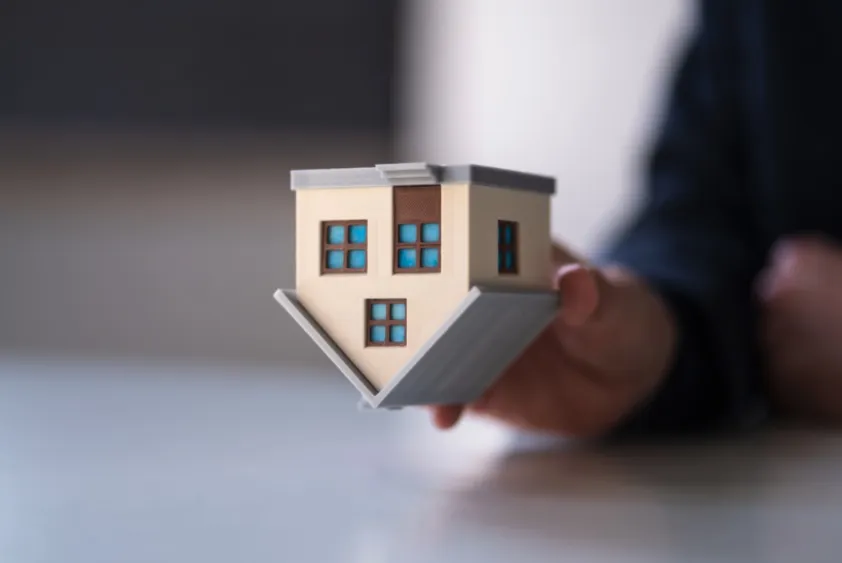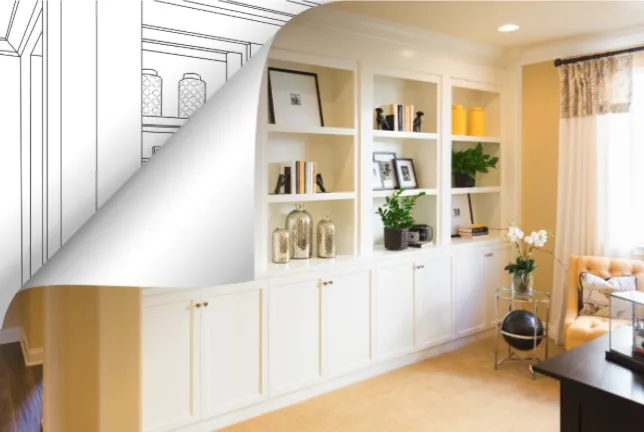Real Estate Flipping: Complete Guide to Success
Discover how to successfully flip real estate: from market research to selling, optimize every step to maximize your profits.
House flipping is a real estate investment strategy that involves buying a property, improving or renovating it, and then reselling it at a higher price in a short period of time, generating a quick profit. Unlike other forms of real estate investment, such as renting properties for passive income, flipping focuses on the rapid appreciation of the asset through improvements, optimizations, or even taking advantage of favorable market conditions.
Key elements of house flipping:
Buying below market value: Investors look for properties that are available at low prices, either because they require significant renovations, are located in emerging neighborhoods, or have been poorly managed. This first step is crucial, as the final profit largely depends on acquiring the property at a cost that allows for covering renovation expenses while still leaving a profit margin at the time of sale.
Renovating or improving the property: Properties bought for flipping often need renovations that increase their market value. These renovations can range from basic repairs (such as improving the structure, plumbing, or electricity) to complete remodels of kitchens, bathrooms, or the creation of new living spaces. The key here is to maintain a balance between the cost of renovations and the value they will add to the property. Not all improvements have the same impact on the final price, so it's important to carefully select the areas of intervention.
Quick sale: After improvements, the goal is to sell the property as soon as possible to take advantage of the increase in value and make a profit. The longer the property remains in the investor's possession, the more costs it generates, such as taxes, maintenance, and potential mortgage payments. The investor must take into account the market timing, seeking to sell in an environment where demand is high and prices are favorable.
How does the house flipping cycle work?
Market research: Investors must first identify areas with growth potential or undervalued properties that can significantly increase in value after renovations. This requires a deep understanding of the local market and real estate trends.
Property acquisition: Often, investors acquire these properties through auctions, quick sales, or direct agreements with owners. It's also common for properties to be in poor condition or foreclosures, which facilitates their purchase at lower prices.
Financing: Although some investors use their own capital, many opt for financing through mortgages, lines of credit, or investment partners. It's important that financial costs do not erode potential profits.
Renovation: During this phase, investors must manage both renovation execution times and budgets, ensuring not to spend more than necessary. Before starting renovations, it's crucial to perform virtual home staging to visualize the space's potential and attract potential buyers, allowing adjustments to renovations according to market preferences.
Sale: Once renovated, the property is listed for sale through real estate agents or online platforms, seeking to maximize market exposure.
House Flipping vs. Traditional Real Estate Investment
Time horizon: Flipping is a short-term investment. Investors seek to buy, renovate, and sell within a matter of months. In contrast, traditional real estate investment, such as property rental, is a long-term strategy to generate passive income.
Risk and reward: Flipping offers the possibility of quick profits, but it also involves higher risk, as success depends on rapid sale in a favorable market. If the market changes or renovation costs are higher than expected, the investor can lose money.
Active management: Unlike traditional investment that can be relatively passive, flipping requires active management. Investors must be involved in every stage, from purchase to renovation and sale.
Key Strategies in House Flipping
To succeed in house flipping, investors must adopt a series of key strategies that allow them to maximize their profits and minimize risks.
1. Market Analysis
Before making any purchase, it's essential to conduct thorough market research. This includes: Comparative Analysis: Study similar properties in the area to understand sale prices, time on the market, and features that buyers are looking for. Market Trends: Stay up to date with local market trends, such as demand for certain locations, housing styles, and popular features. Economic Conditions: Understand how interest rates, unemployment, and other economic conditions can influence the real estate market.
2. Budget and Planning
Careful planning and a solid budget are essential in house flipping. This includes: Cost calculation: Establish a budget that includes the purchase price, renovation costs, closing costs, and agent commissions. It's always recommended to add a contingency margin for unforeseen expenses. Timeline: Create a realistic timeline for the renovation and sale of the property. This helps keep the project on track and ensures it doesn't extend longer than necessary. Trusted Contractors: If you don't have renovation skills, it's vital to find trusted and reputable contractors to do the work. This not only ensures the quality of work but also helps meet established deadlines.
3. Marketing Strategies
Once the property has been renovated, it's crucial to use effective marketing strategies to attract buyers. These may include: Virtual home staging : Use our virtual home staging tool to digitally transform your spaces, allowing you to visualize different decoration and design styles before making any investment. With just a few clicks, you'll be able to experience how your property would look with various furniture and finishes, which will help you make informed decisions and attract more potential buyers with impactful and attractive images. Real Estate Platforms: Use popular real estate platforms to list the property, ensuring it has a detailed and attractive description. Social Media: Promote the property through social media to reach a wider audience. Virtual tour videos can be especially effective.

Selecting the Right Property For Flipping
Choosing the right property is fundamental to success in house flipping. Not all properties have the same profit potential, and knowing what to look for can make the difference.
Factors to Consider When Selecting a Property
Location: Location is one of the most important factors in a property's value. Look for growing areas with good schools, nearby services, and accessible transportation. Property Condition: Assess the overall condition of the property. Some houses may need only aesthetic updates, while others may require significant structural repairs that significantly increase costs. Added Value Potential: Consider the improvements that can be made to increase the property's value. Additions like an extra bathroom, a modern kitchen, or improved outdoor space can attract more buyers and justify a higher price.
How to Identify Good Opportunities
Comparative Sales Analysis: Conduct a comparative analysis to determine the potential resale value of the property. This will help you identify if the property is undervalued. Visits and Evaluations: Don't hesitate to visit properties and, if possible, bring an inspector or contractor with you to get a detailed evaluation of renovation needs.
The Importance of Design and Aesthetics in House Flipping
An attractive design can be the deciding factor in selling a property. Buyers are often influenced by the aesthetics of a home, so investing in good design can offer a significant return.
Effective Design Strategies
Focused Renovations: Concentrate on areas that impact buyers the most, such as the kitchen and bathrooms. These are usually where buyers spend more time evaluating the space. Modern Design Trends: Stay up to date with current design trends. Incorporating modern features, such as open kitchens, stainless steel appliances, and neutral tone finishes can make the property more attractive. Cohesive Style: Make sure all renovations and decorations follow a cohesive style. This helps buyers imagine themselves living in the space and increases the perception of value.
Property Presentation
Virtual home staging : Consider using home staging to show the property at its best. Furniture and decorations can make the space feel more welcoming and attractive. Professional Photography: Invest in high-quality photographs for real estate portals. First impression is key, and a good visual presentation can attract more buyers.

How to Do House Flipping?
While it can be a lucrative path, house flipping also requires knowledge and preparation. Below is a step-by-step approach to carrying out a successful house flipping project.
1. Market Research
Market research is the first essential step in the house flipping process. Understanding the local environment and market trends can make the difference between a successful investment and a loss.
Demand Analysis
Location: As mentioned before, identify growing areas where housing demand is increasing. Properties in neighborhoods with good schools, access to public transportation, and nearby services tend to be more attractive to buyers. Sales Comparables: Conduct a comparative market analysis (CMA) of similar properties that have recently sold in the same area. This will give you an idea of sale prices and features that buyers are looking for.
Tools for Research
Real Estate Portals: Use websites to explore property listings and prices. Sales Data: Access public sales databases and property records to analyze past transactions in the area.
2. Purchase Financing
Once you've identified a promising area and understood the market, the next step is to obtain financing for the property purchase.
Financing Options
Mortgage Loans: You can opt for traditional mortgage loans, but you may need a good credit history and a significant down payment. Flipping Loans: There are lenders specialized in house flipping that offer short-term loans, specifically designed for investors in this field. Private Investors: Consider partnering with private investors who are willing to finance part of the project in exchange for a share of the profits.
3. Property Selection
Choosing the right property is crucial for the success of house flipping. Here are some aspects to consider:
Property Evaluation
Property Condition: Inspect the property to identify the work it needs. Properties that require only aesthetic renovations are ideal, as they involve less risk than those needing serious structural repairs. Value Potential: Evaluate the property's potential for appreciation. Ask yourself if the improvements you plan to make will significantly increase its value.
Selection Tips
Property Visits: Make visits to get a better idea of the space and its needs. Bring an inspector or contractor with you to get a more in-depth evaluation. Location: Remember that location is key. Sometimes, a property in a good location can be more valuable than a larger house in a less desirable area.
4. Renovation Planning
Once you've acquired the property, it's time to plan the renovations. However, before starting any work, visualize how your home would look with virtual home staging . Sometimes, it's more effective to start from a complete vision of the space rather than approaching renovations traditionally.
Establishing a Budget
Renovation Costs: Create a detailed budget that includes all renovation costs. This should cover materials, labor, and a contingency margin for unforeseen expenses. Renovation Timeline: Establish a timeline for renovations, ensuring that all tasks are well-defined and assigned to contractors or team members.
Best Practices for Renovations
Prioritize Critical Areas: Focus your efforts on areas that most impact the buyer's perception, such as the kitchen and bathrooms. Consider modernizing these areas with new appliances and contemporary finishes. Leverage Design Trends: Research current trends in home design and decoration. Aesthetic improvements can attract more buyers and increase resale value.

5. Property Marketing
Once renovations are complete, the next step is to effectively market the property.
Marketing Strategies
Professional Photography: Investing in a professional photographer can make a big difference. High-quality images will attract more interested parties to the property. Online Listings: List the property on real estate portals, making sure to include a detailed and attractive description.
Social Media
Social Media Promotion: Use platforms like Facebook, Instagram, and LinkedIn to reach a wider audience. Post attractive photos and videos, as well as information about the property's unique features. Virtual Tours: Offering virtual tours can be an excellent way to attract potential buyers, especially those who can't visit the property in person.
6. Selling the Property
Once you've marketed the property, you'll be ready to receive offers.
Negotiation Strategies
Evaluating Offers: Be prepared to receive offers and make counteroffers. Consider all conditions and terms, not just the price. Flexibility: Sometimes, buyers may offer less but may be more flexible on other terms, such as the closing date. Evaluate which aspects are most important to you.
Closing the Sale
Documentation: Make sure you have all necessary documentation ready for closing, including inspection reports and any building permits. Collaboration with a Real Estate Agent: Consider working with a real estate agent who has experience in quick sales to guide you through the process and ensure everything is handled correctly.
Advantages of Flipping
House flipping offers a series of advantages that make it an attractive strategy for investors looking to generate profits in the real estate sector. Below are three of the main advantages that make flipping a lucrative option:
1. Potential Short-Term Profitability
One of the main advantages of house flipping is the possibility of obtaining significant profitability in a relatively short period of time. Unlike other forms of real estate investment, such as rental, where income is generated continuously but over the long term, flipping allows investors to generate large profits in a few months, if executed correctly.
How is this profitability achieved?
Buying at a low price: Investors often acquire undervalued or poorly maintained properties that can be purchased at a price below market value. These opportunities can arise from quick sales, bank foreclosures, auctions, or properties in poor condition. Rapid appreciation: Through strategic renovations or improvements, the property's value can increase considerably in a short period of time. Improving key elements such as kitchens, bathrooms, gardens, or even renovating the facade can make a property increase its appeal and sale price. Selling at a higher price: After renovations, the property is quickly resold at a higher price, generating significant net profit for the investor.
For example, if an investor buys a property for $150,000, spends $30,000 on renovations, and then sells it for $230,000, the gross profit would be $50,000, discounting additional costs. All of this could be achieved in less than a year, depending on the market and the size of the property.
2. Investment Flexibility
House flipping offers great flexibility both in terms of how to invest and the approach that can be taken. This allows investors to adapt their strategies based on their capital, experience, and risk tolerance. Some of the ways this flexibility manifests include:
Choice of property type: Investors can opt for different types of real estate for flipping, such as single-family homes, apartments, commercial properties, or even small multi-unit buildings. This allows them to adjust their investment based on the size of the project and the potential for profitability. Financing options: Investors don't always need to have all the capital to acquire a property. They can access various financing options, such as mortgage loans, lines of credit, or partnering with other investors. Additionally, short-term investment mortgages or bridge loans allow financing properties during the renovation process and until sale. Possibility to adapt the project: Depending on the market and the condition of the property, the investor can choose to make minimal renovations or carry out a complete remodel. This flexibility allows adjusting costs and the scope of renovations based on market demand and available resources. Geographic or segment diversification: Flipping allows investing in different geographic markets or specializing in a particular niche. An investor can operate in local markets where they have more knowledge or expand to areas where growth is more promising.
3. Growing Demand in the Real Estate Sector
The real estate sector, in many regions, has seen sustained growth in housing demand, which has created a favorable environment for flipping. This growth is due to several factors, such as population increase, urbanization, economic improvements, and the shortage of affordable housing in some markets. This increase in demand drives the profitability of flipping investments, offering several key advantages:
Dynamic market: In areas where property demand is high, it's easier to find buyers willing to pay higher prices for a home that has been renovated and put in optimal condition. This reduces the risk of the property staying on the market for a long time, which could erode profits. Buyer preferences: With the growth in demand, the number of buyers looking for move-in ready properties or those that have been renovated to modern standards has also increased. This favors investors who carry out quality renovations, as they can sell faster and at higher prices. Opportunities in emerging areas: The growth in demand in certain urban or suburban areas opens the door to identifying developing neighborhoods, where property prices are still low, but a significant increase in value is expected. Buying in these places and selling at the right time allows investors to capitalize on market growth to the fullest.
Strategies in House Flipping
The real estate market is a competitive environment, and to stand out and maximize your profits, it's crucial to implement effective strategies. Below are four key strategies to ensure a successful property sale:

1. Determining the Correct Sale Price
The first step for a successful sale is to establish a price that reflects both the market value and the unique features of the property. Here are some tips:
Market Analysis: Conduct a comparative market analysis (CMA) to understand the prices of similar properties in the same area. This will help you establish a competitive price range. Value Considerations: Take into account factors such as location, size, property condition, and additional amenities. A well-founded price will attract more potential buyers. Flexibility: Be willing to adjust the price according to market response and feedback from visits.
2. Staging for Sale
The presentation of the property can make a big difference in the purchase decision. Try our virtual home staging tool without commitment and perform home staging in a couple of clicks.
3. Timing: When to Sell to Maximize Profit
The timing of the sale can significantly influence the price and speed of the transaction. Here are some aspects to consider:
Seasonality: In many areas, spring and summer are the most active seasons for home buying. Research seasonality in your local market to choose the best time to list. Market Trends: Stay abreast of market trends and mortgage interest rates. Selling when rates are low can attract more buyers. Local Events: Consider the calendar of events in the community. Selling just before a major event can increase the visibility of the property.
4. Negotiating with Buyers: Offers and Counteroffers
The ability to negotiate can make the difference between closing a successful deal and losing a potential buyer. Here are some negotiation strategies:
Active Listening: Pay attention to the buyer's needs and concerns. This will allow you to personalize your offers and make more effective counteroffers. Stay Calm: Negotiation can be emotional. Stay calm and be professional, even if discussions become tense. Flexibility in Terms: Be willing to negotiate not only the price, but also other terms of the sale, such as the closing date or the inclusion of certain furniture and appliances. This can make your offer more attractive.
You can contact us if you have any questions about house flipping and how our tools work from Pedra .

Related Posts
Top 7 AI Room Decoration Tools for 2025
Discover the best AI room decoration software for 2025. Our review compares top tools to help you de...
9 Curb Appeal Ideas on a Budget That Actually Work (2025)
Transform your home's exterior with our top curb appeal ideas on a budget. Get easy, high-impact tip...
10 Essential Curb Appeal Improvements for 2025
Discover 10 essential curb appeal improvements to boost property value. This guide for real estate p...